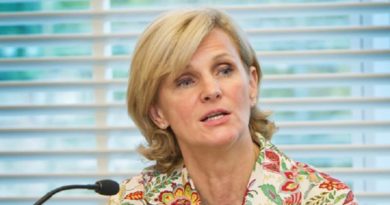Govs, others announce steps to confront climate change at UN Summit
Leaders from government, business, and civil society on Monday 23 September 2019 announced potentially far-reaching steps to confront climate change at the United Nations Secretary-General’s Climate Action Summit in New York.
As carbon pollution, temperatures, and climate destruction continue to rise, and public backlash mounts, the Summit has offered a turning point from inertia into momentum, action, and global impact – if everyone gets on board.
The UN estimates that the world would need to increase its efforts between three- and five-fold to contain climate change to the levels dictated by science – a 1.5°C rise at most – and avoid escalating climate damage already taking place around the world.
However, the Paris Agreement provides an open-door framework for countries to continuously ratchet up their positive actions, and today’s Summit demonstrates how governments, businesses, and civilians around the world are rising to the challenge.
“The best science, according to the Intergovernmental Panel on Climate Change, tells us that any temperature rise above 1.5 degrees will lead to major and irreversible damage to the ecosystems that support us,” said United Nations Secretary-General António Guterres. “Science tells us that on our current path, we face at least 3-degrees Celsius of global heating by the end of the century.”
“The climate emergency is a race we are losing, but it is a race we can win.”
“This is not a climate talk summit. We have had enough talk,” he added. “This is not a climate negotiation summit. You don’t negotiate with nature. This is a climate action summit.”
He said, “Governments are here to show you are serious about enhancing Nationally Determined Contributions under the Paris Agreement. Cities and businesses are here showing what leadership looks like, investing in a green future. Financial actors are here to scale-up action and deploy resources in fundamentally new and meaningful ways. Coalitions are here with partnerships and initiatives to move us closer to a resilient, carbon-neutral world by 2050.”
“And young people are here providing solutions, insisting on accountability, demanding urgent action.”
Increased Ambition, Accelerated Action
The Summit, designed to showcase government, business, and civil society efforts to increase their commitments under the Paris Agreement and work toward reducing emissions to essentially zero by mid-century:
Many countries used the Summit to demonstrate next steps on how by 2020 they will update their Nationally Determined Contributions (NDCs) with the aim to collectively reduce emissions by at least 45 percent by 2030 and prepare national strategies to achieve carbon neutrality by mid-century. President of Chile, Sebastián Piñera, announced the “Climate Ambition Alliance,” which Chile hopes to build in the lead-up to COP25 in Santiago. The Alliance brings together nations upscaling action by 2020, as well as those working towards achieving net zero CO2emissions by 2050. 59 nations have signaled their intention to submit an enhanced climate action plan (or NDC), and an additional 9 nations have started an internal process to boost ambition and have this reflected in their national plans. In terms of the 2050 group, 66 governments are joined by 10 regions, 102 cities, 93 businesses and 12 investors – all committed to net zero CO2emissions by 2050.
The UN Global Compact demonstrated that business is moving, as companies with a combined market capitalization of more than US$2.3 trillion and annual direct emissions equivalent to 73 coal-fired power plants pledged to take action to align their businesses with science-based targets.
Many of the more than 70 key announcements showcase the concrete ways in which countries can better adapt to climate change and cut emissions while getting the necessary technical and financial support many of them need.
Getting out of coal is a priority. The Powering Past Coal Alliance expanded to include 30 countries, 22 states or regions, and 31 corporations committed to stopping the building of new coal power plants in 2020 and rapidly transitioning to renewable energy.
The Summit participants recognize that to limit climate change to 1.5°C, action needs to start now.
The Secretary-General has stated that he, and the entire UN System, will remain engaged in the follow-up of the commitments made today and will work to further scale up and monitor the initiatives to achieve the promised goals and objectives. All initiatives presented to the Secretary-General in the General Assembly Hall will be captured on the UNFCCC Global Climate Action portal. The portal will track the progress of commitments in order to guide the implementation phase of the Paris Agreement post-2020 and towards the global stocktake in 2023.
Climate Finance
The Asset Owner Alliance, a group of the world’s largest pension funds and insurers, responsible for directing more than US$2 trillion in investments, committed to transitioning to carbon-neutral investment portfolios by 2050. The members of the Alliance will immediately start to engage with companies in which they are investing to ensure they decarbonize their business models.
The International Development Finance Club (IDFC) – a leading group of 24 national and regional development banks from all over the world, with a majority active in emerging and developing countries – announced for the first time a quantitative target of mobilizing US$1 trillion by 2025, with at least $100 million for adaptation. In addition, IDFC will launch a partnership with the Green Climate Fund to promote direct access to international climate finance and a new US$10 million Climate Facility to increase capacity to support its members on climate finance.
Unlocking the Potential of Nature in Climate Action
Several countries launched the Global Campaign for Nature, which aims to conserve 30 percent of the Earth’s lands and oceans by 2030.
A new initiative by Central American countries aims, by 2030, to establish and manage 10 million hectares of “sustainable productive landscapes that are resilient to climate change,” with a goal of no less than 40 percent reduction in emissions from the baseline year of 2010.
Launch of a High-Level Panel for the Sustainable Ocean Economy, representing 14 countries that cover approximately 30 percent of the world’s coastlines, 30 percent of the world’s exclusive economic zones, 20 percent of the world’s ocean catch, and 20 percent of the world’s shipping fleet, including a new initiative to build resilience for the ocean and marine-protected areas.
The Central African Forest Initiative (CAFI) will increase the climate ambition and maintain the forest cover of Gabon, Cameroon, Central African Republic, Republic of Congo, the Democratic Republic of Congo, and Equatorial Guinea, allowing the Central African rainforest to continue to provide livelihoods of 60 million people and maintain regional rainfall patterns.
The One Planet Business for Biodiversity, led by the World Business Council for Sustainable Development, will protect and nurture biodiversity through commitments structured around scaling up regenerative agriculture practices, providing a more diversified product portfolio to consumers, and supporting the protection and restoration of high-value ecosystems – including forests.
Live, Work, and Move Green
The Zero Carbon Buildings for All Initiative pledges to make new buildings 100 percent net zero carbon by 2030 and existing buildings by 2050. Multilateral development banks and private financial institutions committed to aligning their financing of buildings with the Paris Agreement and national climate policies—a move that could lead to a potential US$1 trillion in “Paris Compliant” buildings investment in developing countries by 2030.
Two thousand cities committed to strengthening their capacities in project preparation by 2030, placing climate risk at the center of decision making, planning, and investments. Specifically, they committed to creating 1,000 bankable, climate-smart urban projects, linking 1,000 of such projects to finance by 2030 and creating new, innovative financing mechanisms that are utilized by 100 projects until 2025.
The “Action Towards Climate Friendly Transport” initiative includes actions to plan city development to avoid the need to travel, shift from fossil-fueled vehicles to non-motorized and public transport, and improve existing modes of transport through zero-emission technologies.
Assistance for the Least Developed Countries (LDCs)
The Climate Investment Platform will seek to directly mobilize US$1 trillion in clean energy investment by 2025 in 20 least developed countries. The platform will provide a menu of services to governments and private sector clients in their efforts to scale-up energy transition and accelerate investments for low carbon, climate-resilient development. It will also enable the delivery of ambitious NDCs.
The LIFE-AR initiative, led by least developed countries, will strengthen South-South cooperation, aim to mobilize US$30-40 million, and deliver pathways to climate-resilient development by 2030 and net zero emissions by 2050.
Small Island Developing States
Small Island Developing States made a collective commitment to raise the ambition of their NDCs by 2020 and move to net zero emissions by 2050, contingent on assistance from the international community. They intend to move to 100 percent renewable energy by 2030 and provide support for initiatives that aim to address immediate adaptation needs and the transition to climate resilience.
Cutting GHG Emissions Now with Cooling and Energy Efficiency
The “Three Percent Club” – a coalition of countries, businesses, and institutions – commit to putting in place more ambitious energy efficiency policies and working to drive a 3 percent annual global increase in energy efficiency, a target necessary to meet global climate goals while enhancing economic prosperity in all countries.
The Cool Coalition will address cooling as a “major blind spot” by delivering up to 1 degree on the pathway to a 2050 net zero carbon world. With emissions from air conditioning and refrigeration expected to rise 90 percent from 2017 levels by 2050, the collective platform will set ambitious cooling targets and support cross-sectional national strategies and policies such as National Cooling Action Plans.
Toward a Resilient Future, Making People Safer
A coalition led by the private sector – representing more than 20 institutions with US$8 trillion assets under management – was launched at the Summit with the goal of developing and piloting the first framework for the pricing of physical climate risks in infrastructure investing.
African Heads of State announced the African Adaptation Initiative to ensure the continent adapts to climate change in the immediate and longer term and supports regional cooperation.
In an effort to shield vulnerable populations from the economic burden of climate impacts, InsureResilience Partnership 2025 was announced. This effort by governments, multilateral organizations, the private sector, and civil society will help ensure that 500 million poor people worldwide will be covered against climate shocks by pre-arranged risk finance by 2025.
Led by the International Federation of Red Cross and Red Crescent Societies and the United Kingdom, the Risk-Informed Early Action Partnership will help communities and businesses to take early action to prevent disaster. The partnership brings together the humanitarian, development, and climate communities aiming to make 1 billion people safer from disaster, and will deliver new and improved early warning systems.
Recognizing that traditional ways of life have already shifted dramatically in a changing climate, the Governments of Norway, Germany, the Netherlands, and the United Kingdom, as well as the World Bank and the Gates Foundation, announced a plan to support 300 million small-scale farmers in enhancing their resilience to climate shocks and extreme events, increase household incomes and food security, and reverse ecological decline.
People Centered Action Now
The International Labor Organization (ILO) and other members of the Summit’s Social and Political Drivers Action Area, co-led by Spain and Peru, launched the “Climate Action for Jobs” initiative, with the goal of developing a framework for countries that considers job creation, social protection, skills development, and technology and knowledge transfer when taking climate action.
The Safe Air Initiative will call on governments—both national and at the regional or state level—to commit to achieving air quality that is safe for populations and to align their climate change and air pollution policies by 2030, backed up by commitments from financial institutions and funds.
Thirty-two national governments committed to implementing gender-responsive climate change action plans, policies, and strategies and empowering women as leaders of climate action.
The Economy Moving from Grey to Green
A coalition of public and private entities working on the heavy industry transition towards net zero emissions by mid-century set out pathways for carbon intensive sectors to reach net zero emissions by 2050.
The shipping industry launched the Getting to Zero Coalition, bringing together decision makers from across the shipping value chain to reduce GHG emissions by at least 50 percent by 2050 and make the transition to full decarbonization possible. The coalition will develop and deliver a roadmap with tangible steps to accelerate the deployment of zero emissions vehicles.




